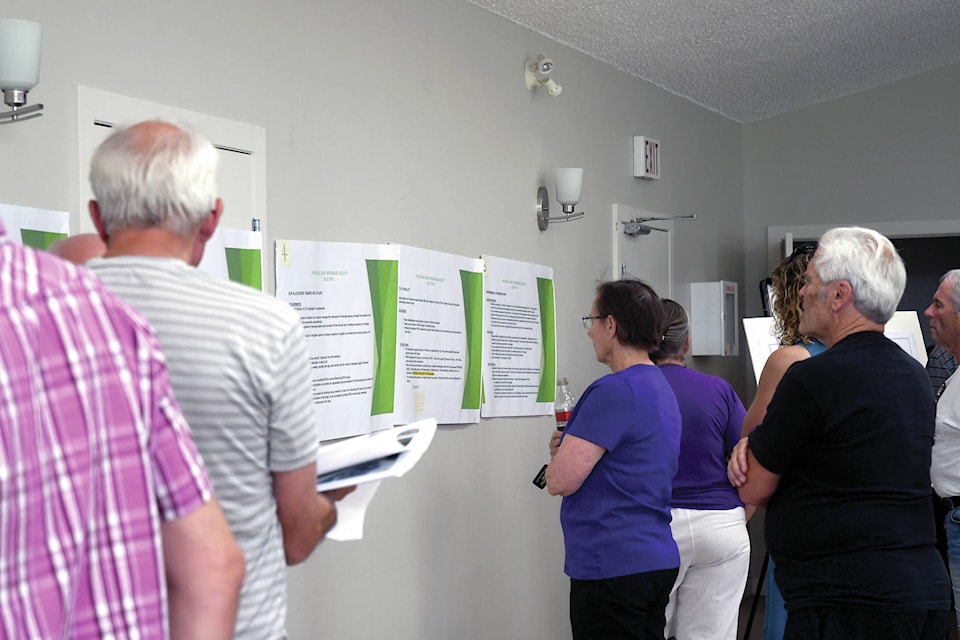This story has been corrected from its original version:
The Regional District of East Kootenay Board voted to allow a new marina on Lake Windermere, at two thirds the size as originally requested by the proponent.
After a lengthy and packed public hearing at the Columbia Valley Chamber of Commerce/Lions Hall on Tuesday July 24th, a controversial marina proposal came before the RDEK board of directors at their meeting on Friday, August 3rd in Cranbrook.
Again, the subject was discussed at length by members of the board, but ultimately the two motions were passed, with opposition from Gerry Wilke, Area G director, mayor of the Village of Radium Hot Springs, and Director Ute Juras, mayor of the Village of Canal Flats. District of Invermere Mayor Gerry Taft abstained from the vote due to a possible conflict of interest as he is a local realtor.
Two bylaws needed to be amended for the plan to move forward, which will change the area of Lake Windermere from a Lake Windermere residential zone and recreation zone, to a Lake Windermere group moorage zone, and sets a cap at not more than 90 boat slips. The RDEK board voted Friday to reduce that number to 60.
The application was put together by the Pedley Community association in partnership with the Baltac Community Association.
This particular area was identified in the 2008 official community plan. At that time there was a specific policy in the OCP to address the buoy farm, which at that time consisted of 46 mooring buoys.
“So we went through the public hearing process last week and we heard over 70 people there, and we did receive a number of written comments as well as verbal comments and some in support and some in opposition,” said Wendy Booth, Director of Electoral Area F. “It was definitely a divided issue.”
The divide between support and opposition of this issue was split nearly 50/50 said Ms. Booth. Some of the concerns brought forward at the Columbia Valley public hearing included the potential increase in vehicle traffic in the area as well as parking and erosion.
“Now regardless of this being approved or not, those would still exist,” Ms. Booth said. “It is a small area, it is a private beach, which they now have as part of this agreement, opened it to the public. There was some other concerns about having a boat carrying capacity study done on the lake.”
Ms. Booth said that in the Lake Windermere Management Plan done in 2011, a boat carrying capacity study was not one of the options they considered. Some of the reasons she cited are that it is very complex and confusing, and in this case, being that there are three different jurisdictions on Lake Windermere, they would have to figure out how to manage all of them as well as the private and public boat launching facilities.
She also added that reducing boat carrying capacity by putting a cap on one lake actually puts additional pressure on other lakes.
“That was one of the requests that came forward and so people were just objecting to having more boats on the lake as well. This proposal would not reduce the amount of boats on the lake and there still is public boat launches that people can access the lake.”
The idea behind the proposal was to have an overnight moorage facility, which would remove existing moored buoys.
“And we do know that an overnight moorage facility is a smaller footprint than all the existing mooring buoys that are there,” Ms. Booth said.
Another aspect of the proposal is to have a $1,000 fee per slip issued for boats, which would be, according to Booth, a voluntary amenity contribution that the developer has offered to the RDEK.
“It’s not something that we requested and it would go to the Regional District. And the concept behind that is to improve access on the lake. It’s very broad in nature … I think there would have to be a bit of work done to where the priorities are, what could be done, that sort of thing and we haven’t had those conversations yet.”
From the perspective of the RDEK, their work is done with this, and it is now up to the applicant to work out how they’re going to proceed, and get permits.
“There is a two step process,” Ms. Booth explained. “There is the re-zoning application that we did here today for the physical docks but there’s also the FrontCounter BC has a tenor application which we recommended to approve a couple months ago if this was approved.”
